coil CHEVROLET CAMARO 1967 1.G Chassis User Guide
[x] Cancel search | Manufacturer: CHEVROLET, Model Year: 1967, Model line: CAMARO, Model: CHEVROLET CAMARO 1967 1.GPages: 659, PDF Size: 114.24 MB
Page 173 of 659

FRONT SUSPENSION 3-9
Inspection
1.
Check bearings for cracked separators or worn or
pitted rollers and races.
2.
Check brake drum for
out-of-
round or scoring.
3.
Check fit of bearing outer cups in hub.
Repairs
Replacement of Bearing Cups
1.
Using steel bar stock, make press-out tools shown in
Figure 11.
2.
Insert removers through hub, indexing ends into slots
in hub shoulder behind bearing cup.
3.
Using a suitable extension pipe or rod, press bearing
cups from hub.
4.
Install new bearing cup in hub using Tool J-8849 on
the outer and Tool J-8850 on the inner cup (fig. 12).
Use Driver Handle J-8092 with the installers. Make
sure that the bearing cups are not cocked and are
fully seated against shoulder in hub.
Installation
1.
Pack both inner and. outer bearings using a high
melting point wheel bearing lubricant.
2.
Place inner bearing in hub, then install a new inner
bearing lip seal assembly. Seal flange should face
bearing cup.
3.
Carefully install wheel hub over steering spindle.
4.
Install outer bearing, pressing it firmly into the hub
by hand.
5.
Install spindle washer and adjusting nut. Draw up
tight and adjust wheel bearings as outlined under
"Front Wheel Bearing Adjustment".
STEERING KNUCKLE
Chevrolet, Chevelle, Camaro and Corvette—It is rec-
ommended that vehicle be raised and supported on a
twin-post hoist so that the front coil spring remains com-
pressed, yet the wheel and steering knuckle assembly re-
main accessible. If a frame hoist is used, support lower
control arm with an adjustable jackstand to safely retain
spring in its curb height position.
Chevy n— While vehicle weight is still on front wheels,
position support between upper control arm and frame
side rail (fig. 13), then raise vehicle and position adjust-
able jackstand under lower control arm.
Removal
1.
Raise vehicle and support lower control arm as noted
above.
2.
Remove hub cap, wheel hub dust cover, cotter pin,
adjusting nut and washer. Withdraw wheel and tire,
brake drum, (or, on Corvette--brake caliper and disc
and hub assembly, See Section 5) and wheel hub and
bearing assembly from steering knuckle spindle.
3.
Remove brake shoes from backing plate (except
Corvette, See Section 5) and clamp wheel cylinder.
CAUTION: Keep brake shoes clean and dry.
4.
Remove brake anchor pin and two bolts securing
brake backing plate and steering arm to steering
knuckle.
5.
Withdraw steering arm and brake backing plate from
steering knuckle. Wire backing plate to frame (fig.
13).
Do not disconnect brake line.
NOTE: Refer to Section 9 - Steering Linkage -
Tie Rod, for further steering arm service
operations.
6. Remove upper and lower ball stud cotter pins and re-
move ball stud nuts. Free steering knuckle from
ball studs by rapping steering knuckle bosses. With-
draw steering knuckle.
Installation
1.
Place steering knuckle in position and insert upper
and lower ball studs into knuckle bosses.
2.
Install ball stud nuts and tighten nut as shown in the
specifications at the end of this section.
Fig.
12 - Installing Front Hub Inner Bearing
Fig.
13 - Backing Plate Removed - Chevy II
CHEVROLET CHASSIS SERVICE MANUAL
Page 176 of 659

FRONT SUSPENSION 3-12
2.
Remove forward nut, retainer and rubber bushing
from front end of strut rod.
3.
Remove two nuts from strut rod to lower control arm
bolts and remove bolts and washers.
4.
Withdraw strut rod from bracket.
5. Remove remaining rubber bushing, retainer, sleeve
and nut from strut rod.
6. Inspect rubber bushings for aging and replace if
necessary. *•
Installation
1.
Screw rear nu$ on forward end of rod and position it
approximately 3/4" from end of threads. Install
rear retainer, sleeve and bushing on rod so raised
pilot diameter faces forward.
2.
Insert strut rod in bracket so pilot diameter on bush-
ing pilots in hole in bracket. Install forward bushing
on sleeve so raised pilot diameter faces rear to
enter hole in bracket, then install forward retainer
and nut on rod.
3.
Attach strut rod to top of lower control arm with two
bolts,
washers and nuts.
4.
Lower vehicle to floor, check caster and camber
angles and adjust where necessary. Torque nuts as
shown in Specifications.
FRONT SPRING
Chevrolet
Removal
1.
With an open end wrench hold the shock absorber
upper stem from turning, and then remove the upper
stem retaining nut, retainer and rubber grommet.
I IVi" rVi"i
\>. j ii
>
I
5'4
s
WOOD
BLOCK
USED
WITH
CHEVROLET
ONLY
Fig.
19
- Spring Removal Tools - Chevrolet, Chevelle and Comoro
2.
With the car supported by the frame so that the con-
trol arms hang free, remove the wheel and tire as-
sembly (replace one wheel nut to retain the brake
drum),
shock absorber, stabilizer bar to lower con-
trol arm link, strut rod to lower control arm attach-
ing, nuts, bolts and lock washers and tie rod end.
3.
Scribe the position of the inner pivot camber adjust-
ing cam bolt and then remove the nut, lock washer
and outer cam.
4.
Install a steel bar (fabricated as shown in Figure 19)
through the shock abosrber mounting hole in the
lower control arm so that the notch seats over the
bottom spring coil and the bar extends inboard and
under the inner bushing. Fit a 5" wood block (See
Figure 19) between the bar and the bushing as shown
in Figure 20.
5.
With suitable jack or hoist, lift up slightly on the end
of the bar to remove the tension from the inner pivot
cam bolt, which can then be removed.
Fig.
18-Strut Rod
Pig. 20 - Front Spring Removal - Chevrolet
CHEVROLET CHASSIS SERVICE MANUAL
Page 177 of 659
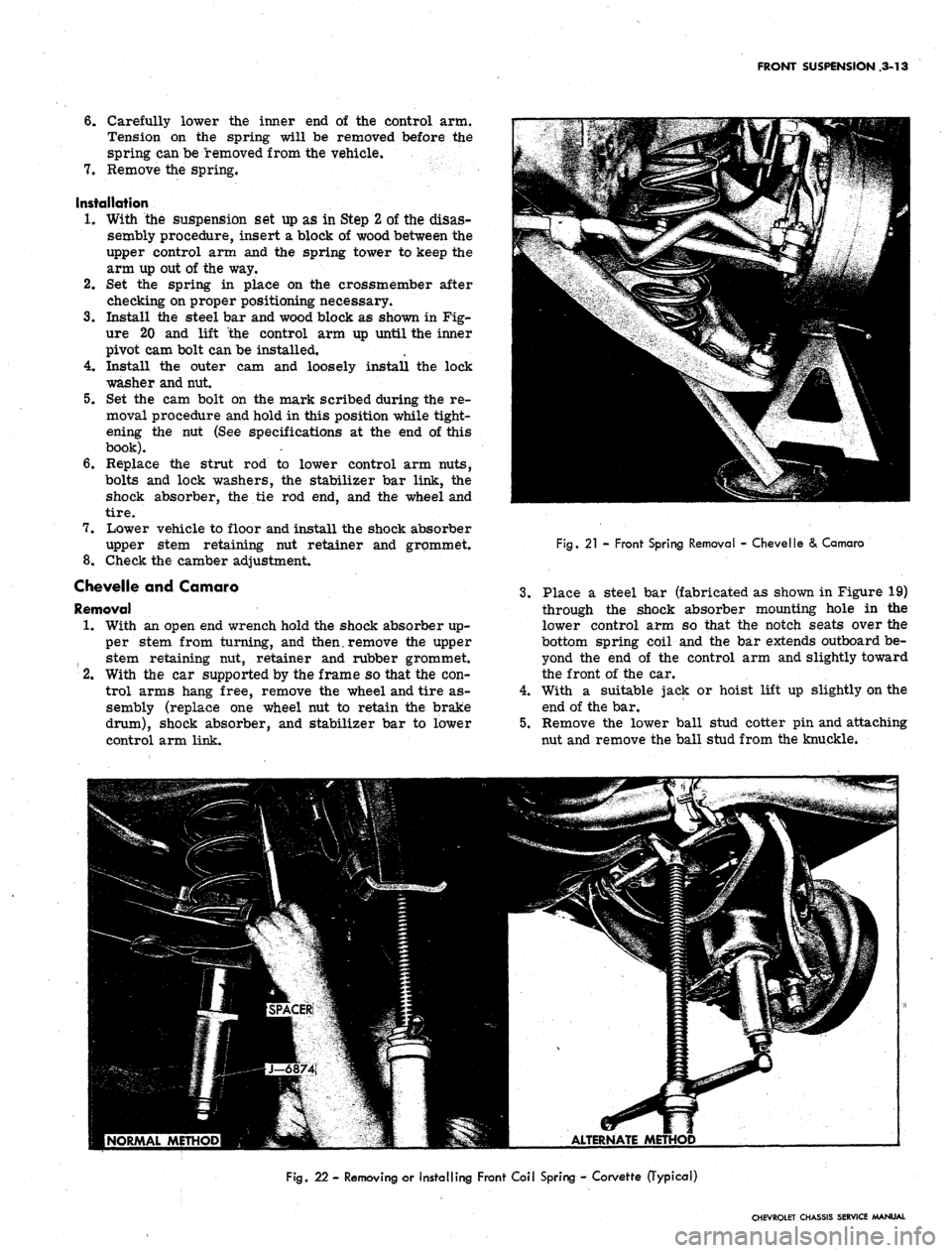
FRONT SUSPENSION ,3-13
6. Carefully lower the inner end of the control arm.
Tension on the spring will be removed before the
spring can be removed from the vehicle.
7.
Remove the spring.
Installation
1.
With the suspension set up as in Step 2 of the disas-
sembly procedure, insert a block of wood between the
upper control arm and the spring tower to keep the
arm up out of the way.
2.
Set the spring in place on the crossmember after
checking on proper positioning necessary.
3.
Install the steel bar and wood block as shown in Fig-
ure 20 and lift the control arm up until the inner
pivot cam bolt can be installed. ,
4.
Install the outer cam and loosely install the lock
washer and nut
5.
Set the cam bolt on the mark scribed during the re-
moval procedure and hold in this position while tight-
ening the nut (See specifications at the end of this
book).
6. Replace the strut rod to lower control arm nuts,
bolts and lock washers, the stabilizer bar link, the
shock absorber, the tie rod end, and the wheel and
tire.
7.
Lower vehicle to floor and install the shock absorber
upper stem retaining nut retainer and grommet.
8. Check the camber adjustment.
Chevelle and Camaro
Removal
1.
With an open end wrench hold the shock absorber up-
per stem from turning, and then, remove the upper
stem retaining nut, retainer and rubber grommet.
2.
With the car supported by the frame so that the con-
trol arms hang free, remove the wheel and tire as-
sembly (replace one wheel nut to retain the brake
drum),
shock absorber, and stabilizer bar to lower
control arm link.
4.
5.
Fig.
21 - Front Spring Removal - Chevelle & Camaro
Place a steel bar (fabricated as shown in Figure 19)
through the shock absorber mounting hole in the
lower control arm so that the notch seats over the
bottom spring coil and the bar extends outboard be-
yond the end of the control arm and slightly toward
the front of the car.
With a suitable jack or hoist lift up slightly on the
end of the bar.
Remove the lower ball stud cotter pin and attaching
nut and remove the ball stud from the knuckle.
ALTERNATE METHOD
Fig.
22 - Removing or Installing Front Coil Spring - Corvette (Typical)
CHEVROLET CHASSIS SERVICE MANUAL
Page 179 of 659
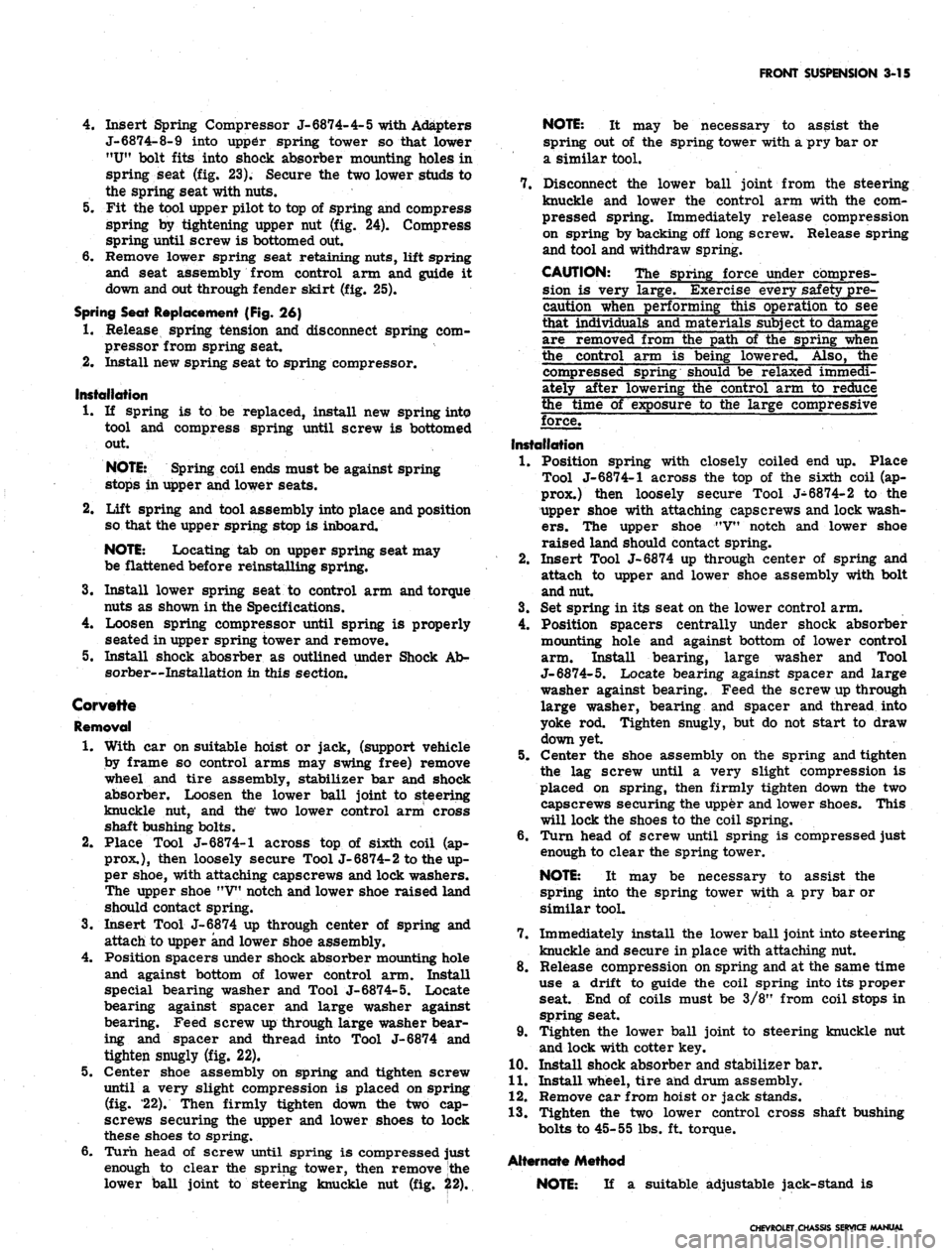
FRONT SUSPENSION 3-15
4.
Insert Spring Compressor J-
6874-
4-
5 with Adapters
J-6874-8-9 into upp^r spring tower so that lower
MU"
bolt fits into shock absorber mounting holes in
spring seat (fig. 23). Secure the two lower studs to
the spring seat with nuts.
5.
Fit the tool upper pilot to top of spring and compress
spring by tightening upper nut (fig. 24). Compress
spring until screw is bottomed out.
6. Remove lower spring seat retaining nuts, lift spring
and seat assembly from control arm and guide it
down and out through fender skirt (fig. 25).
Spring Seat Replacement (Fig. 26)
1.
Release spring tension and disconnect spring com-
pressor from spring seat.
2.
Install new spring seat to spring compressor.
Installation
1.
If spring is to be replaced, install new spring into
tool and compress spring until screw is bottomed
out.
NOTE: Spring coil ends must be against spring
stops in upper and lower seats.
2.
Lift spring and tool assembly into place and position
so that the upper spring stop is inboard.
NOTE: Locating tab on upper spring seat may
be flattened before reinstalling spring.
3.
Install lower spring seat to control arm and torque
nuts as shown in the Specifications.
4.
Loosen spring compressor until spring is properly
seated in upper spring tower and remove.
5.
Install shock abosrber as outlined under Shock Ab-
sorber—Installation in this section.
Corvette
Removal
1.
With car on suitable hoist or jack, (support vehicle
by frame so control arms may swing free) remove
wheel and tire assembly, stabilizer bar and shock
absorber. Loosen the lower ball joint to steering
knuckle nut, and the' two lower control arm cross
shaft bushing bolts.
2.
Place Tool J-6874-1 across top of sixth coil (ap-
prox.),
then loosely secure Tool J-6874-2 to the up-
per shoe, with attaching capscrews and lock washers.
The upper shoe "V" notch and lower shoe raised land
should contact spring.
3.
Insert Tool J-6874 up through center of spring and
attach to upper and lower shoe assembly.
4.
Position spacers under shock absorber mounting hole
and against bottom of lower control arm. Install
special bearing washer and Tool J-6874-5. Locate
bearing against spacer and large washer against
bearing. Feed screw up through large washer bear-
ing and spacer and thread into Tool J-6874 and
tighten snugly (fig. 22).
5.
Center shoe assembly on spring and tighten screw
until a very slight compression is placed on spring
(fig. '22). Then firmly tighten down the two cap-
screws securing the upper and lower shoes to lock
these shoes to spring.
6. Turn head of screw until spring is compressed just
enough to clear the spring tower, then remove the
lower ball joint to steering knuckle nut (fig. 22).
NOTE: It may be necessary to assist the
spring out of the spring tower with a pry bar or
a similar tool.
7.
Disconnect the lower ball joint from the steering
knuckle and lower the control arm with the com-
pressed spring. Immediately release compression
on spring by backing off long screw. Release spring
and tool and withdraw spring.
CAUTION: The spring force under compres-
sion is very large. Exercise every safety pre-
caution when performing this operation to see
that individuals and materials subject to damage
are removed from the path of the spring when
the control arm is being lowered. Also, the
compressed spring
be relaxed immedi-
ately after lowering the control arm to reduce
the time of exposure to the large compressive
force.
Installation
1.
Position spring with closely coiled end up. Place
Tool J-6874-1 across the top of the sixth coil (ap-
prox.) then loosely secure Tool J-6874-2 to the
upper shoe with attaching capscrews and lock wash-
ers.
The upper shoe MV" notch and lower shoe
raised land should contact spring.
2.
Insert Tool J-6874 up through center of spring and
attach to upper and lower shoe assembly with bolt
and nut.
3.
Set spring in its seat on the lower control arm.
4.
Position spacers centrally under shock absorber
mounting hole and against bottom of lower control
arm. Install bearing, large washer and Tool
J-6874-5.
Locate bearing against spacer and large
washer against bearing. Feed the screw up through
large washer, bearing and spacer and thread into
yoke rod. Tighten snugly, but do not start to draw
down yet
5.
Center the shoe assembly on the spring and tighten
the lag screw until a very slight compression is
placed on spring, then firmly tighten down the two
capscrews securing the upper and lower shoes. This
will lock the shoes to the coil spring.
6. Turn head of screw until spring is compressed just
enough to clear the spring tower.
NOTE: It may be necessary to assist the
spring into the spring tower with a pry bar or
similar tool.
7.
Immediately install the lower ball joint into steering
knuckle and secure in place with attaching nut.
8. Release compression on spring and at the same time
use a drift to guide the coil spring into its proper
seat. End of coils must be 3/8" from coil stops in
spring seat.
9. Tighten the lower ball joint to steering knuckle nut
and lock with cotter key.
10.
Install shock absorber and stabilizer bar.
11.
Install wheel, tire and drum assembly.
12.
Remove car from hoist or jack stands.
13.
Tighten the two lower control cross shaft bushing
bolts to 45-55 lbs. ft. torque.
NOTE: If a suitable adjustable jack-stand is
CHEVROLET CHASSIS SERVICE MANUAL
Page 180 of 659

FRONT SUSPENSION 3-16
available the following procedure may also be
used (fig. 22-Alternate Method).
1.
Support car on suitable hoist or jack (so control
arms may swing free) and remove the wheel and
tire assembly, shock absorber, and stabilizer link
at control arm.
2.
Place suitable jack stand under the lower control
arm cross shaft.
3.
Follow Steps 2-5 as outlined on previous page.
4.
Turn head of tool screw to partially compress
spring.
5. Remove the three control arm cross shaft attaching
bolts,
washers and nuts.
6. Carefully lower jack stand and if necessary increase
compression on spring and when coil spring is out of
its upper seat, relax tension on spring (fig. 22).
7. By using a pry bar to assist, if necessary, remove
the coil spring from the lower control arm.
8. Installation is the reverse of the above procedure.
Carefully follow instructions for installing spring
tool.
LOWER CONTROL ARM SPHERICAL JOINT
Chevrolet, Chevelle, Comoro and Corvette
Inspection
The lower control arm spherical joint should be re-
placed whenever wear is indicated in the upper joint
inspection.
NOTE: The lower control arm spherical joint
is a loose fit in the assembly when not connected
to the steering knuckle.
Only if inspection of each upper joint indicates them
both to be within limits, inspect each lower joint for ex-
cessive wear as follows:
1.
After reconnecting upper joints to steering knuckles,
support vehicle weight on wheels or wheel hubs.
2.
With outside micrometer or caliper, measure dis-
tance from top of lubrication fitting to bottom of ball
stud, and record the dimensions for each side.
3.
Then support vehicle weight at outer end of each
lower control arm, so that wheels or wheel hubs are
free,
then repeat Step 2.
4.
If the difference in dimensions on either side is
greater than 1/16" (.0625"), the joint is excessively
worn and both lower joints should be replaced.
If inspection of lower spherical joints does not indicate
excessive wear, inspect further as follows:
5.
On Chevrolet Only--Examine lubrication hole in each
joint assembly after cleaning out hole. Look for evi-
dence of the liner partially or fully blocking lubrica-
tion opening. Such evidence indicates that liner is
disintegrating and that both lower spherical joints
should be replaced.
Another indication of lower spherical joint excessive
wear is indicated when difficulty is experienced when
lubricating the joint. If the liner has worn to the point
where the lubrication grooves in the liner have worn
away, then abnormal pressure is required to force lubri-
cant through the joint. This is another reason to recom-
mend replacement of both lower joints.
If the above inspections do not indicate any reason for
spherical joint replacements, test the torque tightness of
Fig. 27 - Removing Lower Ball Joint - Chevelle
&
Camaro
the lower ball stud in the knuckle on each side as follows:
1.
Wire-brush off nut and cotter pin attaching spherical
joint ball stud to steering knuckle and examine for
evidence of looseness of stud in knuckle.
2.
If no evidence of looseness, remove cotter pin and
with prick punch or equivalent, mark nut stud and
knuckle to identify relative location.
3.
Tighten nut as installed and observe torque reading.
If less than 45 lbs. ft., stud may have been loose in
steering knuckle and replacement of both lower
spherical joints may be recommended.
4.
Check to see if torque of 60-94 lbs. ft. can be ob-
tained without bottoming stud or ball joint against
knuckle. If bottoming occurs, replace ball joint or
steering knuckle.
Chevrolet and Corvette
Removal
1.
Support lower control arm at outer end on floor jack,
with hoist or jack pad clear of lower ball stud nut.
2.
Remove upper and lower ball stud nuts, free ball
studs from steering knuckle and wire knuckle and
brake drum assembly up to fender skirt to preclude
interference while performing next step.
3.
Being careful not to enlarge the holes in control arm,
cut off rivets.
Installation
1.
Install new joint against underside of control arm and
CHEVROLET CHASSIS SERVICE MANUAL
Page 182 of 659
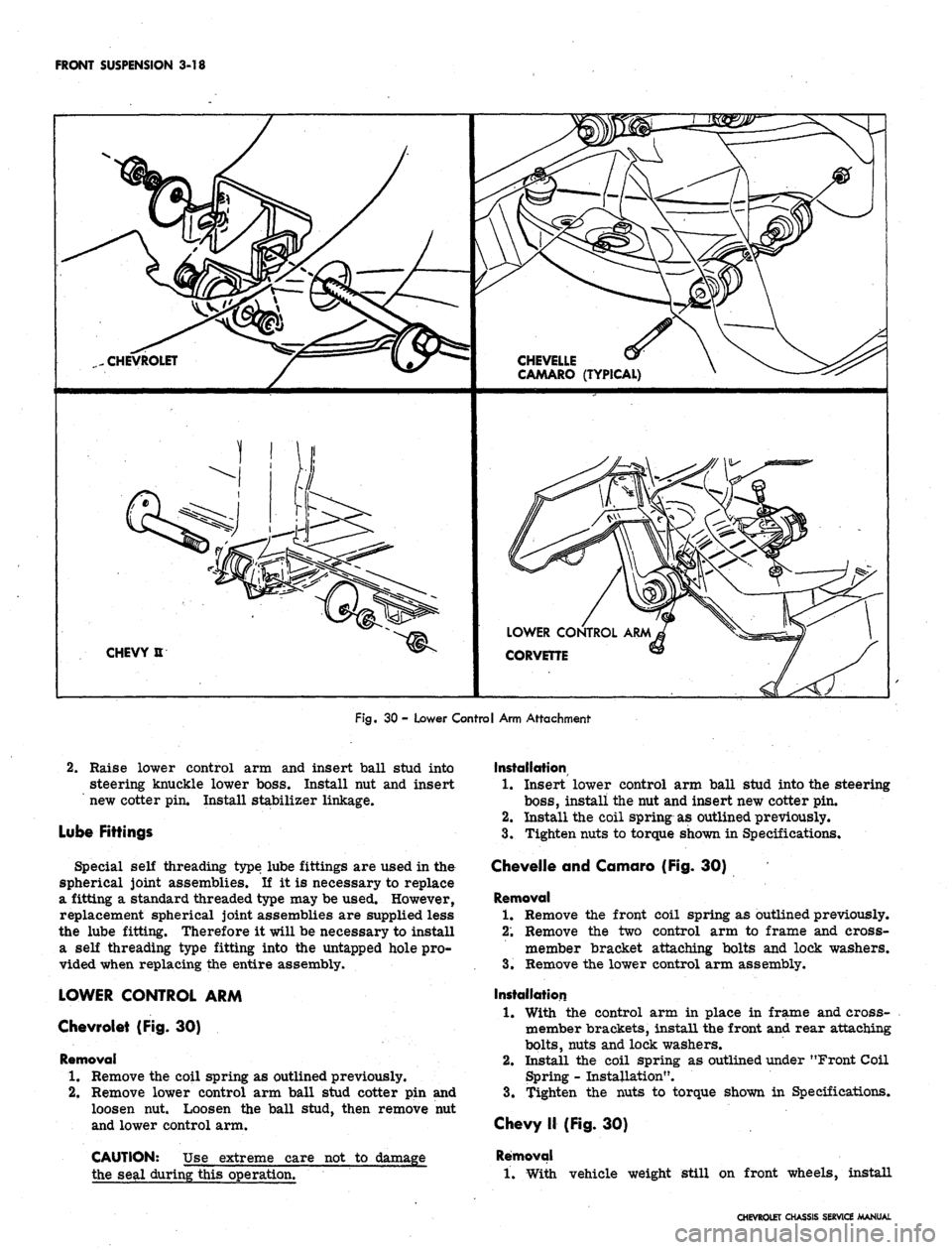
FRONT SUSPENSION 3-18
CHEVROLET
CHEVELLE
CAMARO (TYPICAL)
CHEVY U
LOWER CONTROL ARM
CORVETTE
Fig.
30 - Lower Control Arm Attachment
2.
Raise lower control arm and insert ball stud into
steering knuckle lower boss. Install nut and insert
new cotter pin. Install stabilizer linkage.
Lube Fittings
Special self threading type lube fittings are used in the
spherical joint assemblies. If it is necessary to replace
a fitting a standard threaded type may be used. However,
replacement spherical joint assemblies are supplied less
the lube fitting. Therefore it will be necessary to install
a self threading type fitting into the untapped hole pro-
vided when replacing the entire assembly.
LOWER CONTROL ARM
Chevrolet (Fig. 30)
Removal
1.
Remove the coil spring as outlined previously.
2.
Remove lower control arm ball stud cotter pin and
loosen nut. Loosen the ball stud, then remove nut
and lower control arm.
CAUTION: Use extreme care not to damage
the seal during this operation.
Installation
1.
Insert lower control arm ball stud into the steering
boss,
install the nut and insert new cotter pin.
2.
Install the coil spring as outlined previously.
3.
Tighten nuts to torque shown in Specifications.
Chevelle and Camaro (Fig. 30)
Removal
1.
Remove the front coil spring as outlined previously.
2;
Remove the two control arm to frame and cross-
member bracket attaching bolts and lock washers.
3.
Remove the lower control arm assembly.
Installation
1.
With the control arm in place in frame and cross-
member brackets, install the front and rear attaching
bolts,
nuts and lock washers.
2.
Install the coil spring as outlined under "Front Coil
Spring - Installation".
3.
Tighten the nuts to torque shown in Specifications.
Chevy II (Fig. 30)
Removal
1.
With vehicle weight still on front wheels, install
CHEVROLET CHASSIS SERVICE MANUAL
Page 183 of 659

FRONT
SUSPENSION 3-19
spacer between upper control arm and frame side
rail (fig. 15). Raise vehicle.
2.
Remove lower control arm ball stud cotter pin and
loosen hut.
3.
Loosen ball stud and remove nut. Drop lower control
arm.
CAUTION: Use extreme care not to damage
the seal during this operation? "~~~~
4.
Mark lower control arm pivot bolt and adjusting cam
for realignment. Remove nut securing pivot bolt and
cam assembly. Remove pivot bolt and cam. Remove
lower control arm.
Installation
1.
Insert lower control arm into its support bracket,
index pivot bolt and cams, pivot nut and tighten to
torque shown in Specifications.
2.
Raise lower control arm ball stud into steering
knuckle boss and install nut. Tighten nut to torque
shown in Specifications and insert new cotter pin.
3.
Lower vehicle and remove upper control arm to
frame support.
Corvette (Fig. 30)
Removal
1.
Remove the front coil spring as outlined under
"Front Spring, Removal".
2.
Remove the two front cross shaft to frame attaching
bolts and lock washers and the rear frame attaching
nut and lock washer.
3.
Remove the lower control arm assembly from the
vehicle.
THRUST
BEARING
FLAT
WASHER
REMOVAL
J-21878
J-21830-7
J-21058-8
J-21474-8
/J-21058-15
J-9519-17
J-21830-7
INSTALLATION
J-21058-15
J-2/878 FLAT
REMOVAL
BUSHING
INSTALLATION
BUSHING
CONTROL
J22175
THRUST
ARM
^ ,. / BEARING
Fig.
32 - Lower Control Arm Bushing - Large - Chevelle & Comoro
Installation
1.
Place the control arm so that the cross shaft aligns
with its attaching points.
2.
Attach the cross shaft at the front with two bolts and
lock washers inserted from below into the anchor
BUSHING
REMOVAL
J21474-6
J21474-5
TTf\ ft^\- NUT
BOLT
VHRUST
^22323-^ J21058"8
J21058-15
REARING, / ^_ ^
J21474-13
INSTALLATION
Fig.
31 - Lower Control Arm Bushing - Chevrolet
Fig.
33 - Lower Control Arm Bushing - Small -
Chevelle
& Comoro
CHEVROLET CHASSIS SERVICE MANUAL
Page 184 of 659
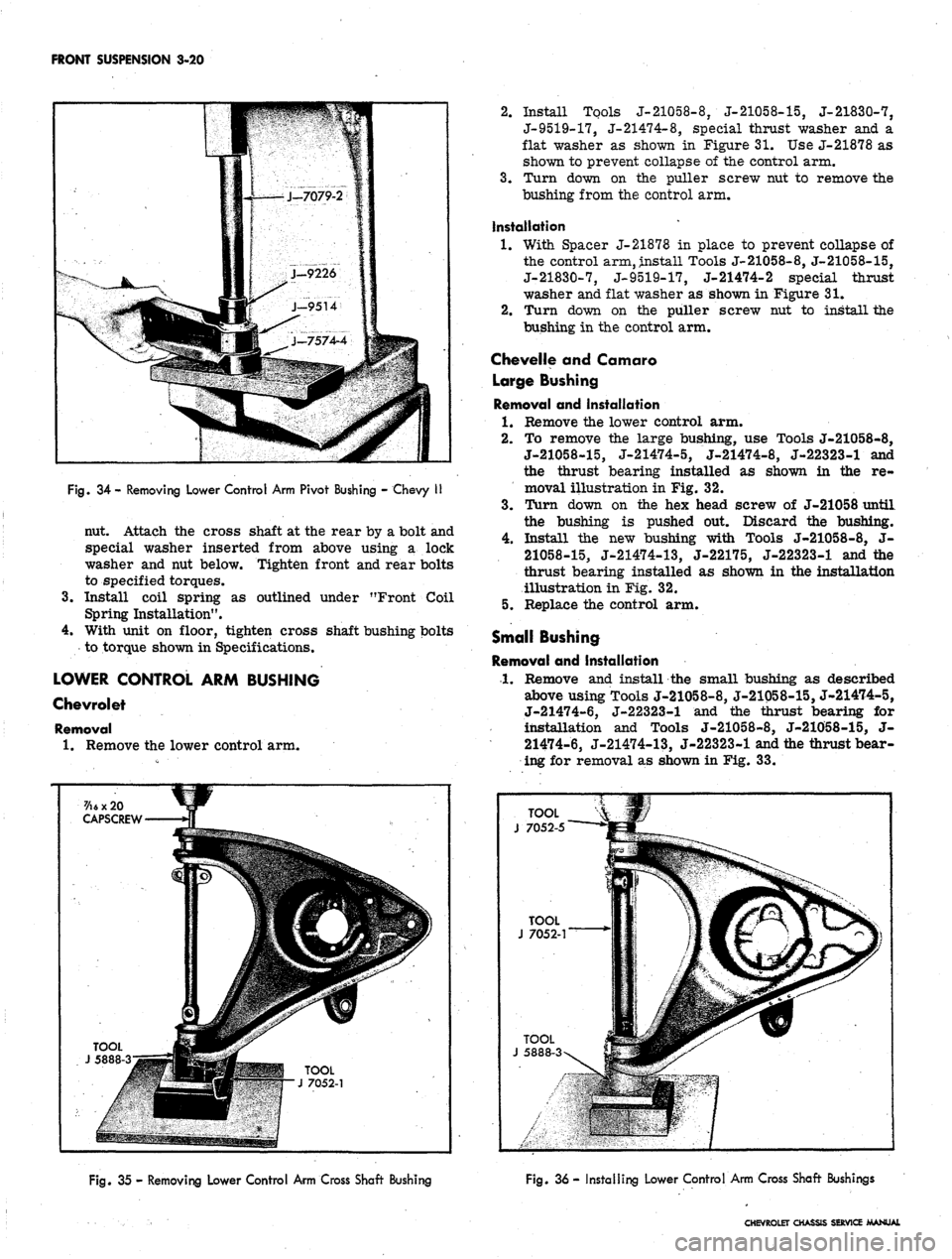
FRONT SUSPENSION 3-20
Fig.
34 - Removing Lower Control Arm Pivot Bushing - Chevy II
nut. Attach the cross shaft at the rear by a bolt and
special washer inserted from above using a lock
washer and nut below. Tighten front and rear bolts
to specified torques.
3.
Install coil spring as outlined under "Front Coil
Spring Installation".
4.
With unit on floor, tighten cross shaft bushing bolts
to torque shown in Specifications.
LOWER CONTROL ARM BUSHING
Chevrolet
Removal
1.
Remove the lower control arm.
2.
Install Tools J-21058-8, J-21058-15, J-21830-7,
J-9519-17, J-21474-8, special thrust washer and a
flat washer as shown in Figure
31.
Use J-21878 as
shown to prevent collapse of the control arm.
3.
Turn down on the puller screw nut to remove the
bushing from the control arm.
Installation
1.
With Spacer J-21878 in place to prevent collapse of
the control arm, install Tools J-21058-8, J-21058-15,
J-21830-7, J-9519-17, J-21474-2 special thrust
washer and flat washer as shown in Figure 31,
2.
Turn down on the puller screw nut to install the
bushing in the control arm.
Chevelle and Camaro
Large Bushing
Removal and Installation
1.
Remove the lower control arm.
2.
To remove the large bushing, use Tools J-21058-8,
J-21058-15, J-21474-5, J-21474-8, J-22323-1 and
the thrust bearing installed as shown in the re-
moval illustration in Fig. 32.
3.
Turn down on the hex head screw of J-21058 until
the bushing is pushed out. Discard the bushing.
4.
Install the new bushing with Tools J-21058-8, J-
21058-15,
J-21474-13, J-22175, J-22323-1 and the
thrust bearing installed as shown in the installation
illustration in Fig. 32.
5.
Replace the control arm.
Small Bushing
Removal and Installation
1.
Remove and install the small bushing as described
above using Tools J-21058-8, J-21058-15, J-21474-5,
J-21474-6, J-22323-1 and the thrust bearing for
installation and Tools J-21058-8, J-21058-15, J-
21474-6, J-21474-13, J-22323-1 and tiie thrust bear-
ing for removal as shown in Fig. 33.
7/\6 x 20
CAPSCREW
TOOL
J 5888-3
TOOL
J 7052-5
TOOL
J 7052-1
TOOL
J 5888-3-
Fig.
35 - Removing Lower Control Arm Cross Shaft Bushing
Fig.
36 - Installing Lower Control Arm Cross Shaft Bushings
CHEVROLET CHASSIS SERVICE MANUAL
Page 191 of 659
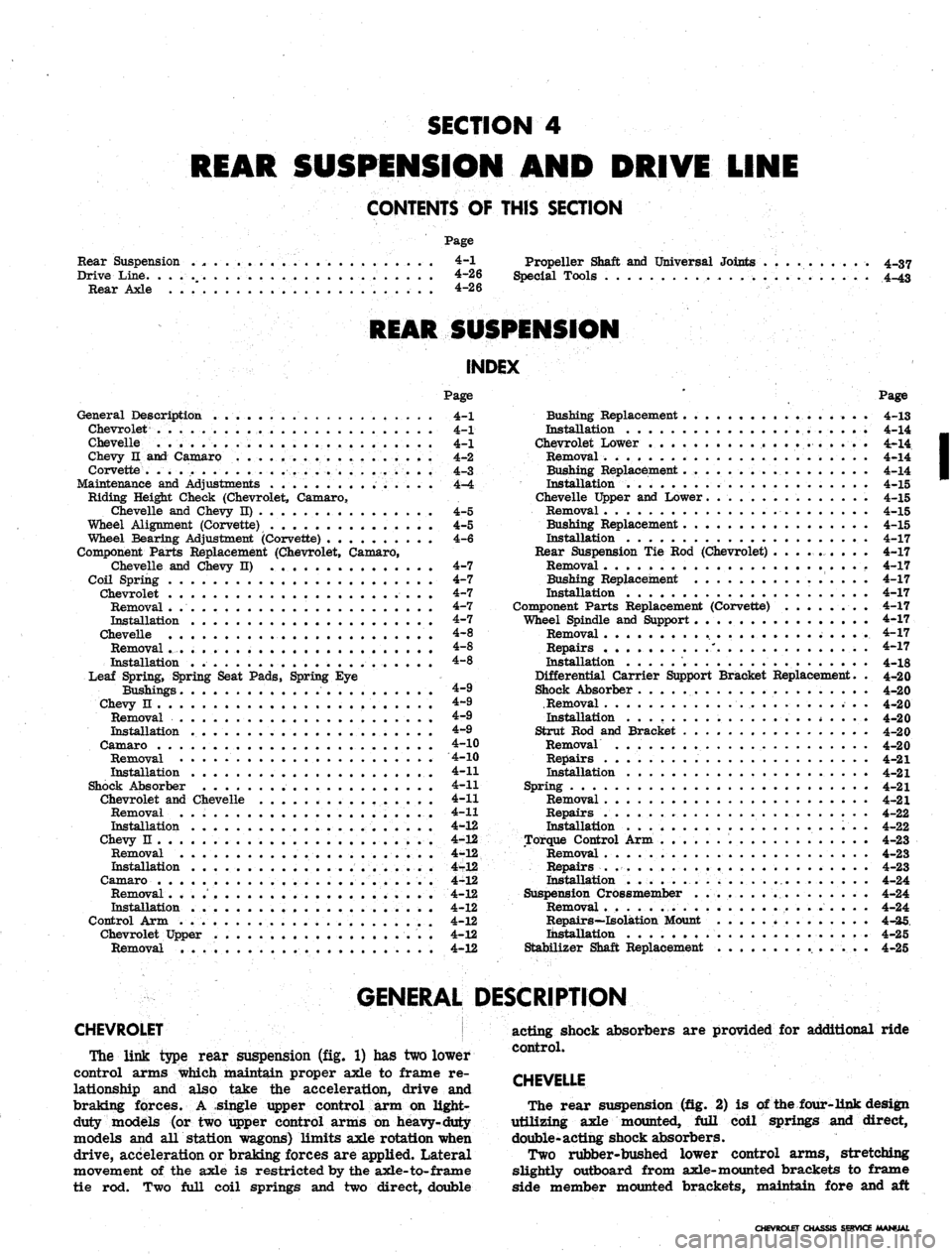
SECTION
4
REAR SUSPENSION
AND
DRIVE LINE
CONTENTS
OF
THIS SECTION
Page
Rear Suspension
4-1
Drive Line.
. 4-26
Rear Axle ......
4-26
Propeller Shaft
and
Universal Joints
Special Tools
4-37
4-43
REAR SUSPENSION
INDEX
General Description
4-1
Chevrolet
4-1
Chevelle
4-1
Chevy
n and
Camaro
. . . . . 4-2
Corvette
. . . . . . 4-3
Maintenance
and
Adjustments ...............
4-4
Riding Height Check (Chevrolet, Camaro,
Chevelle
and
Chevy
II) 4-5
Wheel Alignment (Corvette)
4-5
Wheel Bearing Adjustment (Corvette)
4-6
Component Parts Replacement (Chevrolet, Camaro,
Chevelle
and
Chevy
JJ) 4-7
Coil Spring
4-7
Chevrolet
4-7
Removal
4-7
Installation
4-7
Chevelle
4-8
Removal
4-8
4-8
Installation
.
Leaf Spring, Spring Seat Pads, Spring
Eye
Bushings
4-9
Chevy
H 4-9
Removal
4-9
Installation
4-9
Camaro
4-10
Removal
4-10
Installation
4-11
Shock Absorber
4-11
Chevrolet
and
Chevelle
. 4-11
Removal
4-11
Installation
. . 4-12
Chevy
II 4-12
Removal
4-12
Installation
4-rl2
Camaro
4-12
Removal
. 4-12
Installation
4-12
Control
Arm . . 4-12
Chevrolet Upper
4-12
Removal
. 4-12
Page
Bushing Replacement
. 4-13
Installation
4-14
Chevrolet Lower
4-14
Removal
4-14
Bushing Replacement
4-14
Installation
. 4-15
Chevelle Upper
and
Lower.
. 4-15
Removal
4-15
Bushing Replacement
4-15
Installation
4-17
Rear Suspension
Tie Rod
(Chevrolet)
. . .
......
. . . 4-17
Removal
4-17
Bushing Replacement
4-17
Installation
4-17
Component Parts Replacement (Corvette)
. . 4-17
Wheel Spindle
and
Support
4-17
Removal
4-17
Repairs
', . 4-17
Installation
4-18
Differential Carrier Support Bracket Replacement.
. 4-20
Shock Absorber
4-20
Removal
4-20
Installation
* .... 4-20
Strut
Rod and
Bracket
4-20
Removal
4-20
Repairs
4-21
Installation
4-21
Spring
4-21
Removal
4-21
Repairs
4-22
Installation
4-22
Torque Control
Arm 4-23
Removal
4-23
Repairs
. 4-23
Installation
4-24
Suspension Crossmember
4-24
Removal
4-24
Repairs—Isolation Mount
4-25
Installation
4-25
Stabilizer Shaft Replacement
4-25
GENERAL DESCRIPTION
CHEVROLET
The link type rear suspension (fig. 1) has two lower
control arms which maintain proper axle to frame re-
lationship and also take the acceleration, drive and
braking forces. A single upper control arm on light-
duty models (or two upper control arms on heavy-duty
models and all station wagons) limits axle rotation when
drive, acceleration or braking forces are applied. Lateral
movement of the axle is restricted by the axle-to-frame
tie rod. Two full coil springs and two direct, double
acting shock absorbers are provided for additional ride
control.
CHEVELLE
The rear suspension (fig. 2) is of the four-link design
utilizing axle mounted, full coil springs and direct,
double-acting shock absorbers.
Two rubber-bushed lower control arms, stretching
slightly outboard from axle-mounted brackets to frame
side member mounted brackets, maintain fore and aft
CHEVROLET CHASSIS SERVICE MANUAL
Page 192 of 659

REAR SUSPENSION AND DRIVE LINE 4-2
SHOCK ABSORBER
UPPER ATTACHMENT
COIL SPRING
\
R.H. UPPER
CONTROL ARM
LH.
UPPER
CONTROL ARM
(HEAVY DUTY AND
STATION WAGON)
TIE ROD
ATTACHMENT
SHOCK ABSORBER
LOWER ATTACHMENT
LOWER
CONTROL ARM
Fig.
1—Chevrolet Rear Suspension Components
relationship of the axle assembly to the vehicle proper.
These lower control arm axle brackets also mount the
axle rebound bumpers and provide for lower attachment
of the shock absorber. Upper attachment of the shock
absorber is a platform mount to the rear of the coil
spring frame bracket. The coil springs are pigtailed
at both ends; the upper end is isolated from the frame
seat by a rubber insulator, while the lower end seats
on the axle mounted spring bracket which has a vertical
flange to retain the spring.
Sideways movement of the axle assembly is controlled
by two angularly mounted, rubber-bushed upper control
arms.
Projecting ears, cast as part of the differential
carrier, provide for rear attachment and frame cross-
member mounted brackets retain them at the forward
end.
CHEVY 11 AND CAMARO
The.Chevy n and Camaro rear suspension (fig. 3 and
fig.
4) consists of two uniformly stressed rear springs
and two shock absorbers mounted to the spring lower
seats.
The
.
springs are rubber mounted at both axle
and frame attaching points, thus insuring uniform spring
loading, minimizing transmittal of road vibration to
passenger compartment, and providing a pivot point to
•MMMi
MMM—Hi—1—1——1——1MMMMiM_
[•?{aw-i
'
"'
i
\ SHOCK^^BBB^^B(^^CO1L
ABSORBER ^HH^ SPRING
g^8^"
_ LOWER
feSfcto^
CONTROL
ARM
Fig.
2—Chevelle Rear Suspension Components
CHEVROLET CHASSIS SERVICE MANUAL